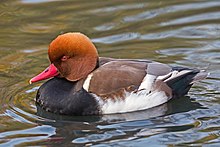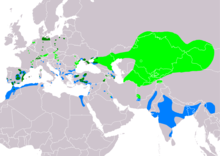
The diving ducks, commonly called pochards or scaups, are a category of duck which feed by diving beneath the surface of the water. They are part of Anatidae, the diverse and very large family that includes ducks, geese, and swans.
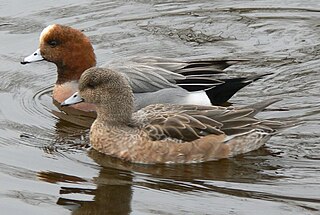
The Eurasian wigeon, also known as the widgeon is one of three species of wigeon in the dabbling duck genus Mareca. It is common and widespread within its Palearctic range.

The redhead is a medium-sized diving duck. The scientific name is derived from Greek aithuia, an unidentified seabird mentioned by authors including Hesychius and Aristotle, and Latin americana, of America. The redhead is 37 cm (15 in) long with an 84 cm (33 in) wingspan. Redhead weight ranges from 2.0-2.5 lbs, with males weighing an average of 2.4 lbs and females weighing an average of 2.1 lbs. It belongs to the genus Aythya, together with 11 other described species. The redhead and the common pochard form a sister group which together is sister to the canvasback.

The common pochard is a medium-sized diving duck. The scientific name is derived from Greek aithuia an unidentified seabird mentioned by authors including Hesychius and Aristotle, and Latin ferina, "wild game", from ferus, "wild".

The garganey is a small dabbling duck. It breeds in much of Europe and across the Palearctic, but is strictly migratory, with the entire population moving to southern Africa, India, Bangladesh and Australasia in winter, where large flocks can occur. This species was first described by Carl Linnaeus in his landmark 1758 10th edition of Systema Naturae. Like other small ducks such as the common teal, this species rises easily from the water with a fast twisting wader-like flight.

The tufted duck is a small diving duck with a population of close to one million birds, found in northern Eurasia. The scientific name is derived from Ancient Greek aithuia an unidentified seabird mentioned by authors including Hesychius and Aristotle, and Latin, fuligo "soot" and gula "throat".

The long-tailed duck, commonly known in North America as oldsquaw, is a medium-sized sea duck. It is the only living member of its genus, Clangula. This was formerly used for the goldeneyes, with the long-tailed duck being placed in Harelda, but the latter is the type species of the genus. An undescribed congener is known from the Middle Miocene Sajóvölgyi Formation of Mátraszőlős, Hungary.

The red-breasted merganser is a diving duck, one of the sawbills. The genus name is a Latin word used by Pliny and other Roman authors to refer to an unspecified waterbird, and serrator is a sawyer from Latin serra, "saw". The red-breasted merganser was one of the many bird species originally described by Carl Linnaeus in his landmark 1758 10th edition of Systema Naturae, where it was given the binomial name Mergus serrator.

The ruddy duck is a duck from North America and one of the stiff-tailed ducks. The genus name is derived from Ancient Greek oxus, "sharp", and oura, "tail", and jamaicensis is "from Jamaica".

The ferruginous duck, also ferruginous pochard, common white-eye or white-eyed pochard is a medium-sized diving duck from Eurosiberia. The scientific name is derived from Greek aithuia an unidentified seabird mentioned by authors including Hesychius and Aristotle, and nyrok, the Russian name for a duck.

The common scoter is a large sea duck, 43–54 cm (17–21 in) in length, which breeds over the far north of Europe and the Palearctic east to the Olenyok River. The genus name is derived from Ancient Greek melas, "black", and netta, "duck". The species name is from Latin niger "shining black". The black scoter of North America and eastern Siberia is sometimes considered a subspecies of M. nigra.
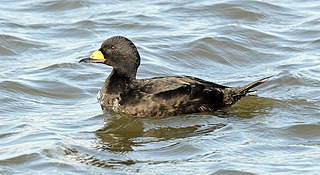
The black scoter or American scoter is a large sea duck, 43 to 49 cm in length. The genus name is derived from Ancient Greek melas "black" and netta "duck". The species name is from the Latin for "American ". Together with the common scoter M. nigra, it forms the subgenus Oidemia; the two are sometimes considered conspecific, the black scoter then being referred to as M. nigra americana. Its French name, used in parts of its Canadian range, is macreuse noire. The species is listed as Near Threatened by the IUCN.
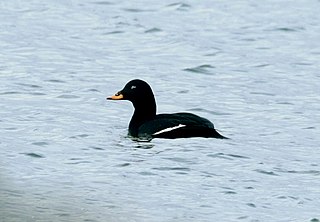
The velvet scoter, also called a velvet duck, is a large sea duck, which breeds over the far north of Europe and the Palearctic west of the Yenisey basin. The genus name is derived from Ancient Greek melas "black" and netta "duck". The species name is from the Latin fuscus "dusky brown".

The ruddy shelduck, known in India as the Brahminy duck, is a member of the family Anatidae. It is a distinctive waterfowl, 58 to 70 cm in length with a wingspan of 110 to 135 cm. It has orange-brown body plumage with a paler head, while the tail and the flight feathers in the wings are black, contrasting with the white wing-coverts. It is a migratory bird, wintering in the Indian subcontinent and breeding in southeastern Europe and central Asia, though there are small resident populations in North Africa. It has a loud honking call.

The lesser crested tern is a tern in the family, Laridae.

The black-headed duck is a South American duck allied to the stiff-tailed ducks in the tribe Oxyurini of the family Anatidae. It is the only member of the genus Heteronetta.

The marbled duck, or marbled teal is a threatened, medium-sized species of duck from southern Europe, northern Africa, and western and central Asia. The scientific name, Marmaronetta angustirostris, comes from the Greek marmaros, marbled and netta, a duck, and Latin angustus, narrow or small and -rostris billed.

The rosy-billed pochard, alternatively named rosybill or rosybill pochard, is a member of family Anatidae. Though classified as a diving duck, this pochard feeds more like a dabbling duck feeding on seeds roots, sedges, aquatic plants and other grasses. Netta is Ancient Greek for "duck" and peposaca is a transcription of the Guaraní name of this species which means "showy wings", referring to the broad white stripe that is only visible with stretched out wings. Male characteristic features include a bright red bill with a rounded knob at the base.
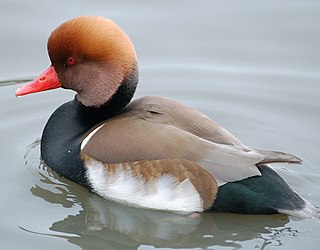
Netta is a genus of diving ducks. The name is derived from Greek Netta "duck". Unlike other diving ducks, the Netta species are reluctant to dive, and feed more like dabbling ducks.
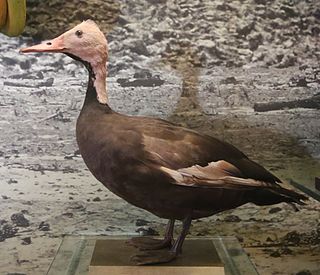
The pink-headed duck is a large diving duck that was once found in parts of the Gangetic plains of India, Bangladesh and in the riverine swamps of Myanmar but feared extinct since the 1950s. Numerous searches have failed to provide any proof of continued existence. It has been suggested that it may exist in the inaccessible swamp regions of northern Myanmar and some sight reports from that region have led to its status being declared as "Critically Endangered" rather than extinct. The genus placement has been disputed and while some have suggested that it is close to the red-crested pochard, others have placed it in a separate genus of its own. It is unique in the pink colouration of the head combined with a dark body. A prominent wing patch and the long slender neck are features shared with the common Indian spot-billed duck. The eggs have also been held as particularly peculiar in being nearly spherical.
